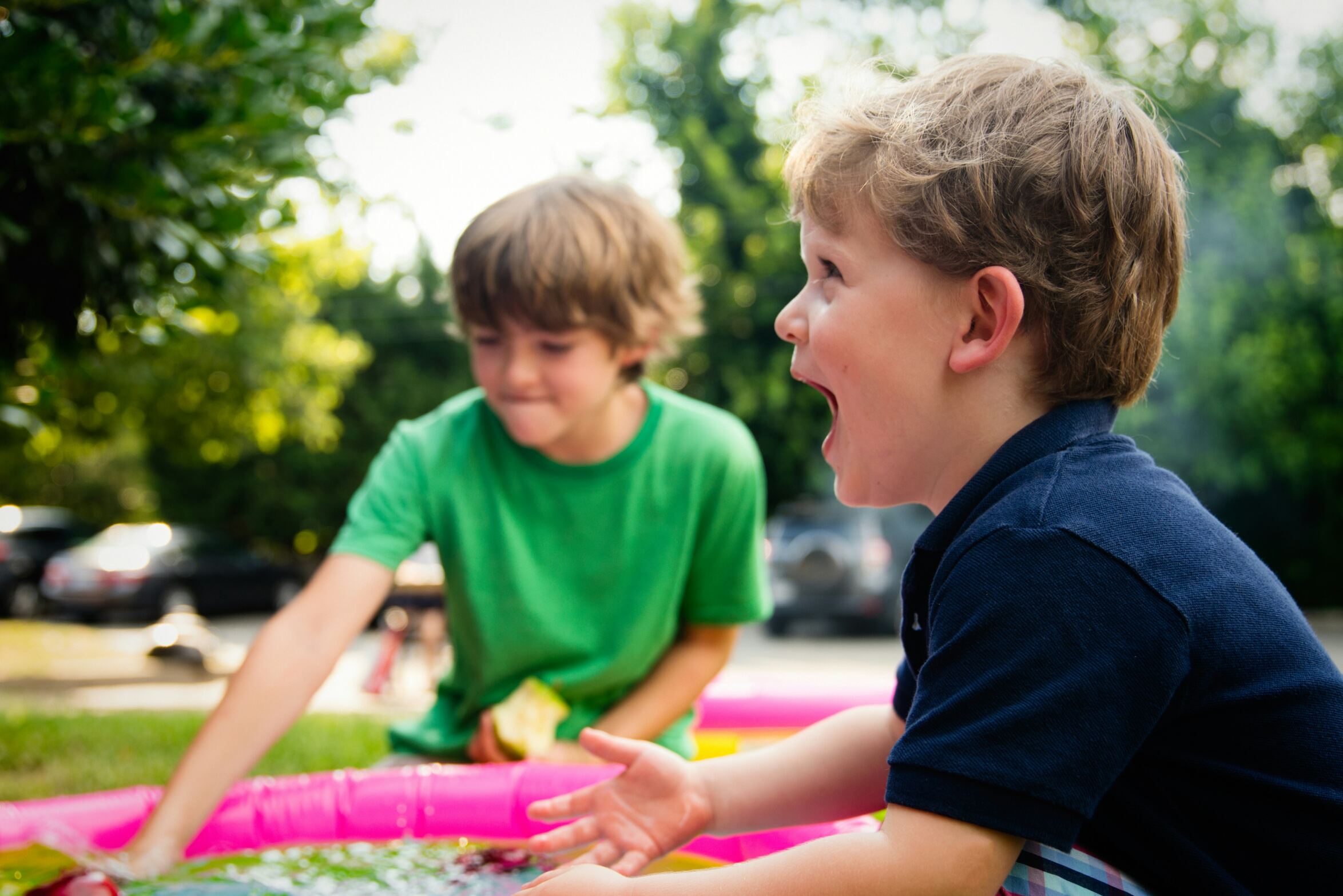How Play Evolves Consciousness:
From the first days in the body there are movements, reflexes. These are the first movements, the playfulness that kicks our feet, gurgles from our mouths, and curls our toes. This playful action is stimulated through the interchange of desires and incoming sensations. As we begin to interact with sensations we start to explore the nature of being in a body to the world around us.
At this young age, we don’t think to learn. Through play and the motion inside the body we feel to learn. The body says, “Let’s see, if I feel how to reach this way, do I get…? If this is what I want, I will try the feeling again. If the action induces success, desires and actions want to be repeated. Repeated patterns of action are what help build memory. The awareness through motion senses, “If I do this… I will get that.” Muscle patterns and coordination are what start to develop our perception.
From the playfulness of motion that become patterns of actions start to make cognitive distinctions, build neural pathways of behavior, and develop our perceptual processing.
We need to play to feel the sensory acuity of our bodies and what they can do for us. Play then forms the basis for interactive movement and learning, and is subsequently a key building block from which we develop as a human being.
“Movement is crucial to all other brain functions -perception, attention, emotion – and affects the highest cognitive processes of memory, thinking, and learning.” (Ratey, 2001, p. 175)
The biological longing for joy:
In children (and the child in us all) there is a fermented desire to play.
The definition of play, in this context, is the intrinsically motivated, freely chosen, pleasurable, non-literal, active movement of the participant. “Play” is not sitting at a computer playing a game or collecting information. Because, in those activities, the life source of the body is masked. Foundational to what makes us feel alive, happy, and full of wonder is the felt experience of “play.”
To re-enter the power of play is to return to our nature, part of us that is wiser than intellectual cognition. This “nature” creates all learning. What we learn, becomes who we are. The essence of playfulness fuels the source of living. Play maps out elements of time and space of what moves or not moves in the body and present surroundings. It is what happens between the mind and body that creates the maps.
Play is also a sensory extravaganza that helps us find balance. The “balance” is the learning between our “inner me” and our “outer me.” A mind and body in tune with itself, and curious and engaged with the world around it. Finding this balance is a lifelong journey and play creates the conditions for it to be a fruitful adventure. When we are balanced in this way, internal honesty and external justice fill the pores. Our thoughts, words and actions find resonance, and we feel the potency of our innate self. In the experience of play, the biological wisdom is birthed and self awareness is developed. This template of “balance” is between our hearts, heads, and souls.
Here are some of the key ways that Play influences us:
- Play softens the mind and opens the heart.
- Play creates the willingness to learn.
- Play embodies the activity of all learning and memory.
- Play radiates enthusiasm from the richness of sensory acuity.
- Play creates a container of creative processing.
- Play wakes up what was thought of as separate to a unity.
- Play taps into a subtle commentary of wisdom in the biological intelligence of human nature.
- Play likes opposing forces to learn what is in the middle that goes beyond both.
Play is learning:
There are many research studies about the value of play and learning. Learning comes from sensations of motion, not just thinking (Spencer, J.P., Corbetta, D., Buchanan, P., Clearfield, M., Ulrich, B., Schoner, G., 2006). However, to introduce a new perspective to research, switch the focus of learning and play to: “What is in the body that makes play so crucial to learning?” Or, a better question is, how do we tap into this nature?
Go into a room of twenty-two five-year-olds and imagine what you could do to get their attention. If you have something fun, suddenly, all eyes are on you. “Fun” lassos the inner conversations of the physicalness to the outer conditions of the moment. Play sets the stage for the inner and outer worlds to come together, and create a space, a container, to go beyond what is known.
For example, five-year-olds like to go wild; it’s their biological nature to move and have fun. The problem is they don’t want to listen. What do you do if their “biological wisdom” says to go wild. You follow the nature of them wanting to “go wild,” however, set up containers. The first container is a boundary line they cannot leave. Play big-beat music and tell them to go wild; however, the second container is they can’t bump into each other. Watch what happens. They bump into each other. Why? Because they are full of sensation but don’t know where they are in space. You just found the third “container” of nature, the body. This lack of “Body Ownership” (Ehrsson, HH, 2005) plays with the nature inside to the nature around for learning. Body Ownership is the experience of the “ah ha” moment of one’s body as one’s own, and actions and intentions match.
If children play, joyful shrills fill the air. Sound is not just a sound (Steinbach, 1994/ Goddard, 2002). Sound is energy, vibration, and motion playfully passing from the body to the brain. The significance of sounds is so immeasurable that scientists are baffled by the depth it gives to learning. Sound isn’t the only sense that helps learning. We are sensory maps learning how to “play” to develop. Dynamic sensory maps send information (Smetacek & Mechsner, 2004. p. 21) from the body to the brain. Sensations of sensory input are triggered by actions, sounds, smells, sights, tendencies, yearnings, and desires all trying to balance between the body, brain, and the outer world.
People today are becoming desensitized to the nature around them as they become more desensitized to the nature within them.
Playing is the intrinsic motivation for sensory mindfulness. In other words, play finds a way to open the curtain desensitizing you, and look what’s behind it.
Sensory mindfulness is the wizard behind the curtain and who we become. This nature of sensory mindfulness is an internal spatial awareness of the sensory extravaganza mapping learning. A Sensory Body (SB) is an intelligence that feels sensations of movements in actions, emotions, sounds, breath and more through muscles and bones. Like a multi-billion-dollar biofeedback machine, the SB “plays” to read life.
For a direct link to diminishing aggression in children, steer the course of action towards play. The “play” between the opposing forces of what is attention “out there” and to an inner attention. If you turn aggressive attention from “out there” to the inside, sensory impulses pop up revealing a more meaningful way to handle the moment. Principal Danny Garcia did a lesson to turn attention inward with every child who was sent to his office for bullying. Attention turned inward with the breath, the Home Breath, what seemed to be causing the conflict changed. There was no longer just the problem with someone else. Attention turned inside the body and introduced to a dialog of inner processing, and the anger became diffused. The bullying stopped in his school.
It is important to note these children learned SB awareness.
Born in each body is a gift, a rich and joyful biological nature that wants to play. As our cognition develops, something fades away – the feeling of play. Attention conditioned to point both “out there” and “inside” takes the two opposing forces and finds the space to grow and go beyond what we already know. With the pure heart of play behind the steering wheel and our brains in the back seat, playfulness creates happiness. When happiness returns, balance and well-being returns, and learning grows.
References:
- Ehrsson, H. H. (2012) The concept of body ownership and its relation to multisensory integration, A new handbook for multisensory processing (p.775-792). Cambridge: MIT Press.
- Feldenkrais, M. (1979). Body and mature behavior. New York, NY: International Universities Press, Inc.
- Goddard, S. (2002). Reflexes, Learning and behavior: A window into the child’s mind. Eugene, OR: Fern Ridge Press.
- Goldstein, B. (2010). Sensation and perception 8th edition. Belmont, CA: Wadsworth, Cengage Learning.
- Hannaford, Carla. (2002) Awakening the Child Heart. Captain Cook, Hawaii: Jamilla Nur Publishing.
- Keleman, S. (1985). Emotional Anatomy. Berkeley, CA: Center Press.
- Blaydes Madigan, J. (2000). Thinking on Your Feet. Murphy, TX: Action Based Learning.
- Smetacek, V., & Mechsner, F. (2004). Cognitive Science: On Proprioception. Nature, 432, p. 21.
- Spencer, J. P., Clearfield, M., Corbetta, D., Ulrich, B., Buchanan, P., and Schöner, G. (2006).Moving toward a grand theory of development: in memory of Esther Thelen. Child Dev. 77, 1521.
- Stokes, B. (2002). Amazing Babies, Essential Movement for Your Baby in the First Year. Toronto, ON: Move Alive Media Inc.
- Zosh, J. M., Hopkins, E. J., Jensen, H., Liu, C., Neale, D., Hirsh-Pasek, K., Solis, S. L., & Whitebread, D. (2017). Learning through play: a review of the evidence (white paper). The LEGO Foundation, DK.

Wellness Through Movement: https://wellnessthroughmovement.com
Get Started: https://wellnessthroughmovement.com/programs-2

